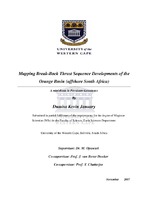| dc.contributor.advisor | Opuwari, M. | |
| dc.contributor.author | January, Dumisa Kevin | |
| dc.date.accessioned | 2018-02-08T10:15:57Z | |
| dc.date.available | 2018-04-30T22:10:06Z | |
| dc.date.issued | 2017 | |
| dc.identifier.uri | http://hdl.handle.net/11394/5700 | |
| dc.description | Magister Scientiae - MSc | |
| dc.description.abstract | In the present study thrust sequence developments in the sediments below the deep-waters of the Orange Basin are mapped. Four seismic sections are interpreted from four different locations of the study area. The interpreted seismic sections show various ranges of shortening as a result of the thrust developments. The Orange Basin provides exceptional 3-D structures of folds and faults generated during soft-sediment slumping and deformation which is progressive in nature. 3-D seismic section and structural evaluation techniques have been used to understand the geometric architecture of the gravity collapse structures. The interpretation of gravitational tectonics indicates a significant amount of deformation that is not accounted for in the imaged thrust belt structure. The Study area covers 8200 square kilometres (km2) of the total 130 000 km2 area of the Orange Basin offshore South Africa. The southern parts of the study area are largely featureless towards the shelf edge. The northern area has chaotic seismic tectonic thrust sequence features as a result of increase in shortening. Episodic gravitational collapse system of the Orange Basin margin characterizes the late Cretaceous post-rift evolution. This study area shows that implications of stress field and thrust faulting relating to the thickness change by gravity collapse systems are not only the result of a combination of geological processes such as rapid sedimentation, margin uplift, geotectonics and subsidence but also due to a possible meteorite impact. These processes caused gravitational potential energy contrast and created gravity collapse features that are observed between 3000-4500ms TWT intervals in the seismic data. The gravity-driven system in the study area is divided into three distinct structural domains, based on the cross strike variations in structural style. From northeast to southwest these are: an up-dip extensional domain characterized by basin-ward-dipping listric faults, a transitional domain with both contractional and extensional features and a down-dip contractional domain that consists of landward-dipping thrust faults and associated thrust fault-related folds. Gas escape structure features were identified in the study area and have been interpreted to have formed as a result of normal faulting and extension. Gravity collapse systems of the Orange Basin were the main driving mechanism behind the thrusting sequences that lead to break-back thrusts. | |
| dc.language.iso | en | |
| dc.publisher | University of the Western Cape | |
| dc.title | Mapping Break-Back Thrust Sequence Developments of the Orange Basin (offshore South Africa) | |
| dc.rights.holder | University of the Western Cape | |

